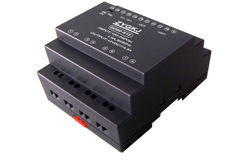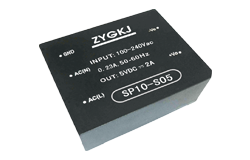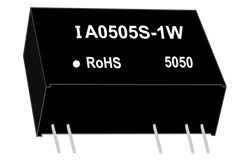ข่าว
Designing an AC-DC Converter Circuit
Author: ZYG Power Module Time: 2023-4-27
Designing an AC-DC Converter Circuit
An AC-DC converter circuit is a type of electronic circuit that converts alternating current (AC) to direct current (DC). This type of circuit is commonly used in power supplies for electronic devices and appliances. Designing an AC-DC converter circuit involves selecting the appropriate components and designing a circuit that can efficiently convert AC to DC.
The first step in designing an AC-DC converter circuit is to determine the requirements for the circuit. This includes the input voltage, output voltage, output current, and efficiency. The input voltage is the AC voltage that will be supplied to the circuit. The output voltage is the DC voltage that the circuit will produce. The output current is the current that the circuit will be able to supply to the load. Efficiency is the ratio of the output power to the input power.
Once the requirements have been determined, the next step is to select the appropriate components for the circuit. This includes selecting the transformer, diodes, capacitors, and voltage regulator. The transformer is used to step the voltage up or down depending on the requirements of the circuit. The diodes are used to rectify the AC voltage and convert it to DC. The capacitors are used to smooth out the DC voltage and reduce ripple. The voltage regulator is used to regulate the output voltage and ensure that it remains constant even with changes in the input voltage or load.
After selecting the components, the next step is to design the circuit. This involves determining the values of the components and the connections between them. The values of the components are determined based on the requirements of the circuit and the characteristics of the components. The connections between the components are designed to ensure that the circuit operates as intended and that the components are properly controlled.
Once the circuit has been designed, the next step is to build a prototype of the circuit. This involves assembling the components and testing the circuit to ensure that it operates as intended. The prototype is used to identify any issues with the circuit and to make any necessary modifications.
Finally, once the prototype has been tested and any issues have been addressed, the final step is to produce the final circuit. This involves assembling the components onto a printed circuit board (PCB) and testing the circuit to ensure that it operates as intended. The final circuit is then ready to be used in power supplies for electronic devices and appliances.
In conclusion, designing an AC-DC converter circuit involves determining the requirements for the circuit, selecting the appropriate components, designing the circuit, building a prototype, and producing the final circuit. By following these steps, a reliable and efficient AC-DC converter circuit can be designed and produced.
ก่อนหน้า: Building a 120V AC Power Supply for 3V DC Output
ต่อไป: AC-DC Converter Module: Efficient Power Conversion Solution
ข้อมูลที่เกี่ยวข้อง
-
2023-7-20
Electric Power Series manufacture: Harnessing Energy for the Future
Introduction: In today's world, the demand for energy is increasing at an unprecedented rate. As we strive to meet this demand, it is essential to explore sustainable sources of energy that have a minimal impact on the environment. The electric power series is a revolutionary concept that aims to harness renewable energy and pave the way for a greener future. This article delves into the various aspects of the electric power series and its potential to transform the energy landscape. 1. Understanding the Electric Power Series: The electric power series is a comprehensive approach to energy production, distribution, and consumption. It integrates multiple sources of renewable energy, such as solar, wind, hydro, and geothermal, to create a reliable and sustainable...
ดูรายละเอียด -
2023-6-30
12V AC to DC Converter Module: Providing Efficient Power Conversion in English Language
Introduction: In today's fast-paced world, electronic devices have become an integral part of our daily lives. From smartphones to laptops, we rely heavily on these gadgets to stay connected and get things done. However, these devices require a stable and efficient power source to function optimally. This is where the 12V AC to DC converter module comes into play. In this article, we will explore the importance of this module and how it provides efficient power conversion to ensure the smooth operation of electronic devices. Understanding the 12V AC to DC Converter Module: The 12V AC to DC converter module is a device that converts alternating current (AC) into direct current (DC) at a voltage output of 12 volts. This...
ดูรายละเอียด -
2023-5-25
High-Efficiency 12V AC-DC Converter for Reliable Power Supply
Introduction In recent years, the demand for energy-efficient and reliable power supply solutions has increased significantly. This has led to the development of various power conversion technologies. One such technology is the high-efficiency 12V AC-DC converter, which converts alternating current (AC) to direct current (DC) at a voltage of 12 volts. This article discusses the working principle, advantages, and applications of high-efficiency 12V AC-DC converters. Working Principle A high-efficiency 12V AC-DC converter consists of several components, including a rectifier, filter, and voltage regulator. The rectifier converts the AC input voltage to a pulsating DC voltage. The filter removes the ripple from the DC voltage, resulting in a smoother DC output voltage. The voltage regulator regulates the output voltage to a...
ดูรายละเอียด -
2023-12-15
DC-DC Power Supply Module: Efficient and Reliable Energy Conversion Solution
In today's technologically advanced world, the demand for efficient and reliable energy conversion solutions has never been higher. One such solution that has gained significant popularity is the DC-DC power supply module. This article aims to explore the features and benefits of this module and shed light on its importance in various industries. Efficiency and Reliability: The DC-DC power supply module stands out for its exceptional efficiency and reliability. It is designed to convert the direct current (DC) input voltage to a different DC output voltage, making it an indispensable component in many electronic devices. This module ensures that the output voltage is stable and matches the requirements of the device it powers. One of the key advantages of the...
ดูรายละเอียด -
2023-10-11
Dual Power Supply Module: Ensuring Reliable and Efficient Energy for Your Devices
Introduction: In today's technologically advanced world, the importance of reliable and efficient energy supply for electronic devices cannot be overstated. From small handheld gadgets to large-scale industrial equipment, uninterrupted power is crucial for seamless operation. To address this need, the dual power supply module has emerged as a game-changer, offering enhanced reliability, flexibility, and efficiency. This article explores the features and benefits of the dual power supply module in ensuring reliable and efficient energy for your devices. 1. Understanding the Dual Power Supply Module: The dual power supply module is a sophisticated technological solution that allows devices to operate seamlessly by simultaneously drawing power from two independent power sources. Typically, it consists of two power input channels and a power...
ดูรายละเอียด -
2023-7-5
Bidirectional DC-DC Converter: An Efficient Solution for Power Conversion
Introduction: Power conversion plays a crucial role in various applications such as renewable energy systems, electric vehicles, and energy storage systems. The bidirectional DC-DC converter has emerged as an efficient solution for power conversion due to its ability to transfer power bidirectionally between two DC voltage sources. This article aims to explore the working principle, advantages, and applications of bidirectional DC-DC converters. Working Principle: A bidirectional DC-DC converter consists of two unidirectional converters, namely the buck converter and boost converter, connected back-to-back. The buck converter steps down the input voltage, while the boost converter steps up the voltage. These converters are controlled by a high-frequency switching mechanism that allows energy transfer bidirectionally. During the step-down mode, the buck converter operates...
ดูรายละเอียด


















